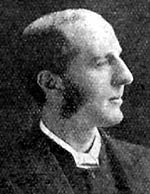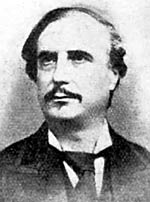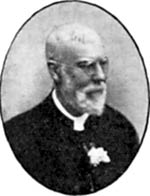LEONARD LINDLEY was a lace dresser and sewing machine manufacturer. He was Sheriff in 1876, and on the extension of the Borough was, with Messrs. Acton and Ford, elected to the Council for Forest Ward. He became an Alderman in 1881, and the following year Mayor. He was one of the principal promoters in the building of Redcliffe Road Church. He was chairman of the University College Committee at the time of his death in 1895.
WILLIAM LAMBERT was a lace dresser. He resided for some years at Mapperley Hall. His chief public work was that for many years he was Chairman of the Public Parks Committee, during which some of the principal adornments of the City, such as the Trent Embankment, Vernon and Victoria Parks, Lenton and Radford Recreation Grounds, etc., werecarried out. He was Sheriff in 1860, Mayor 1874 and 1885. He died at Lenton Firs in 1905, aged 82.
He was one of the first members of the Robin Hoods, made Captain in 1865, and was Major when he died.
THOMAS BULL, a joiner, will be remembered in connection with his Pavilion and its curiosities. He held a Certificate of Merit "for Originality of Design and Excellence of Workmanship in Rustic Work," granted to him at the "Notts, and Midland Counties' Working Classes' Art and Industrial Exhibition" held in 1865, on the site of the University College. He died in 1908, in his 86th year.
ABRAHAM PYATT was a timber merchant, and for about 19 years resided in a house on Redcliffe Road. He gave close attention to his business, and as a trader was just in his dealings. He took an active part in religious matters, and was one of the principal promoters, and a generous supporter of the Wesleyan Albert Hall Mission, as he had previously been in connection with Halifax Place Mission. In this and other philanthropic work he was heartily supported by his wife. He took great interest in the volunteer movement, and was one of the earliest members of the Robin Hoods. He was a City Magistrate, and also a member of the City Council for 22 years, and was elected an Alderman. Having served as Sheriff in 1897, he was elected Mayor in 1899. He died in 1908, aged 64.
CHARLES BENNETT was an example of how a poor lad with many disadvantages may raise himself. Sent to work at Mapperley brickyards when only 9 years of age, and with no schooling, he became an ordinary workman, then a foreman, manager of the works of the Nottingham Patent Brick Company, a Town Councillor (28 years), Alderman, Magistrate. He was the moving spirit in the purchase and allotment into 800 gardens of the Porchester Estate. He gave the land for the Wesleyan Chapel at Mapperley. He died 1909, aged 77.
ROBERT HALFORD, J.P., for 28 years resided at "Ash Tree," on Magdala Road. As a youth he was educated at the Grammar School in Stoney Street, and became a clerk and collector in the office of Mr. E. M. Kidd, House Agent, and when Mr. Kidd desired to give up that branch of his business, Mr. Halford in 1865 took to it, and joined with Mr. Baker, who was for many years Parish Clerk at St. Nicholas' Church. Under Mr. Halford's energetic management the business was so largely extended that it became by far the largest house agency in the county. He was thorough in his work, and his methods were such as to inspire absolute confidence in his judgment and integrity, accompanied by unfailing courtesy. As a Valuer he was reliable. On no conditions would he give evidence as an expert witness. He became a Director of the Commercial Union, and other Companies. As Chairman of the Nottingham & Notts. Bank, the Bank developed its business, and secured the confidence of its customers. In early life he was a member of the Robin Hoods, and throughout life he took a keen interest in national sports. The east window in St. Jude's Church, with scenes of the Ascension and the eleven apostles, was given in memory of his mother, and another window in St. Mary's Church was dedicated to the memory of his wife. He died in 1910, aged 70.
Miss ALICE OLDACRES, born in 1852, was the daughter of a Vicar of Woodborough, and afterwards lived with her mother at "the Hollies," Mansfield Road. She was a woman of great energy, and very fine feelings, a great worker among the poor, and much beloved. For many years she conducted a Band of Hope of about 200 children, and many of the inhabitants of Carrington still owe much to her influence. She also conducted at her own house a Bible Class for young men, all of whom were devoted to her. She was voluntary organist at the church, and never failed in her duties, even in failing health. She died in 1910, and a marble tablet in the church truly says "She hath done what she could."
The Oldacres were a remarkable family, and in 1875 the Rev. S. L. Oldacres wrote "I challenge the kingdom to find a parish where scholastic and clerical duties have been performed by one family for such small remuneration for 112 years." For three generations they taught the village day school, and conducted the clerical duties on a miserable stipend. See the "History of Woodborough," by the Rev. W. E. Buckland, to be had at the post office there for l/-

Rev. T. J. Rider.
The REV. T. J. RIDER, B.A., was Vicar of Carrington six years. A parishioner who knew him well describes him as "a fine type of the English clergyman, who combined the physical with spiritual enjoyments, a good preacher and visitor, a fine cricketer, rider and shot, he lost his life in the hunting field, and died at Baschurch, Shropshire." An artizan writes: "He was very popular with young men, he could keep them together. You could talk to him just like one of yourselves. He was highly esteemed throughout the country. One of his sons was a Shropshire vicar, and a daughter is the wife of Captain Dundas, the brother of Mrs. Austen Chamberlain. The Carrington Church presented him with a sideboard, and the cricket club gave a marble clock, suitably inscribed." The Vicar of Baschurch writes: "He did a splendid work here as vicar for 28 years. He died on October 2nd, l9ll, suddenly, falling dead from his horse."

Dr Bell Taylor.
CHARLES BELL TAYLOR was a surgeon occulist. His father, brother, and nephews were, or are, veterinary surgeons in Nottingham. He lived and died at Beechwood Hall, Mapperley Park. He took the degree of Doctor of Medicine at Edinburgh in 1854, became F.R.C.S. (Edinburgh) in 1867, and in addition had quite a long list of medical qualifications. He was at one time President of the Parisian Medical Society. He was appointed surgeon of the Nottingham Eye Infirmary in 1859, and filled that office with great distinction for nearly half-a-century. As an operator he was without a rival. He was the first to perform the operation for cataract without leaving a scar. He had a world-wide reputation. His rooms were crowded. He would have a hundred consultations in a day, and say ten operations. He frequently lectured on his special subjects, and many of his lectures were reported in the Lancet between 1884 and 1895, one of the most valuable being entitled "Eye Diseases in General Practice." "These lectures," says the Lancet, "were models of simple, clear, and incisive style, and they were further illustrated with careful drawings, made and engraved upon wood, for Dr. Taylor never would have a process block of any kind." The amount of work he did was enormous. "Probably," says the British Medical Journal, "his abstemious mode of living, combined with his great vitality to produce this result; he never had more than two meals a day, and he abstained altogether from alcohol, tobacco, and even from tea and coffee. Certainly it is given to few men to perform as he did at 80 years of age, the most exacting operations, with a hand as steady as in his prime." He contributed papers to the Medical Times for upwards of thirty years, the last being only a month before his death.
He was very kind to the poor. He was a great lover of animals, and was never tired of writing against vivisection. The Animals Guardian was a favourite publication of his. He had two white carriage horses, which, with his brougham, were well known. They followed him to the graveside. He was a strong individualist, and hated compulsion. He invariably quoted Pope's words, both in relation to human beings and animals, for they represented the religion of his life :—
"Teach me to feel another's woe,
To hide the faults I see, That
mercy I to others show That
mercy show to me."
His remains were cremated, and the ashes were buried in the Nottingham General Cemetery, where, east of the top chapel, there is a striking monument, having a medallion portrait of the deceased, with, at the foot, a dog in repose. He died in 1909, aged 80.
WILLIAM B. TATE, M.D., M.R.C.P., M.R.C.S., was for the long period of 54 years the Medical Superintendent of the Coppice Lunatic Hospital, that is from its opening to his death in 1913, at the ripe age of 86 years. He became, in 1862, first churchwarden of St. Ann's, and so continued many years.
The REV. JOHN F. MAKEPEACE, M.A., was, when the Sherbrooke Road Baptist Chapel was built, its minister, and was an able, and scholarly preacher. He was for six years vice-chairman of the Nottingham School Board, and was chairman of the School Management Committee, being an enthusiast for education, and on his retirement in 1901 a special vote recording his valuable services was passed. He was also active in connection with juvenile temperance work, and being cheerful, courteous, and kind-hearted, was much esteemed. He retired from the ministry a few years ago, and is now residing in Yorkshire.
JOSEPH BURTON, of Carrington, is still living, and is 85 years of age, having been born at Basford in 1828, so he may well be named. He has been a preacher for 68 years, and still frequently officiates. He was president of the Baptist Local Preachers' Association in 1898. He was a Guardian of the poor for some years, and for more than 30 years he has been a manager of Board and Council Elementary Schools. He has been a deacon of Sherbrooke Road Church 26 years, and is still vigorous.
 Canon Tebbutt.
Canon Tebbutt.The REV. H. J. TEBBUTT, M.A., became Curate of St. Mary's in 1860, and four years later, while Canon Brooks was building St. Ann's, he was transferred to that newly-created parish, which included Mapperley (see page 171). He finished the church internally, built the schools, and afterwards the vicarage on Woodborough Road. In 1871 the big parish of St. Ann's was divided, and Mr. Tebbutt went to the St. Andrew's part, and he promoted the building of the church, vicarage, schools, and parish-room. In 1886 he went to Doncaster, and afterwards to Beeford. He was the active promoter of the Nottingham Church Spiritual Aid and Church Mission Fund, for which £30,000 was raised. He was made a Canon of Lincoln, and afterwards of Southwell, at which latter place he is spending a well-earned retirement, after the work of an earnest preacher, a generous giver, an active builder, with great ability for business, and an earnest desire to promote the public good.
SIR ARTHUR L. LIBERTY was the son of Mr. Arthur Liberty, of No. 698 Mansfield Road, Cavendish Hill, lace manufacturer. He was born in Bucks, in 1843, and educated at Mr. Geo. Herbert's school in Waverley Street. At 16 he went into a business house in London, where oriental fabrics were sold, and deeming their artistic designs and colours much superior to ordinary English make, he, while an assistant made himself fully acquainted with the materials, methods, and art coloring, so that in five years time he became manager of the shop, and then formed the acquaintance of artists—Whistler, Rossetti, Watts, Burne-Jones, Wm. Morris, and others, and loving art he went to their studios. In 1875 he started business for himself, and with his little savings took half a shop in Regent Street, and began his work of inducing manufacturers to produce the finest textiles as heretofore made in the East, with soft delicate colours, of vegetable dies, and artistic designs. The half-shop has become a score of shops, factories, works, etc., the business is now a Limited Liability Company, the name of Liberty, and their fabrics are now known and valued the world over. Sir Arthur Liberty is Lord of the Manor of The Lee, Bucks., and patron of the living, was High Sheriff of Bucks, in 1899, is a member of the County Council, Deputy Lieutenant, has liberally supported a number of institutions tending to the religious, intellectual, and social advancement of the people, and was knighted by the King for his worthy action in founding an original School of Art, whereby the manufacturer is educated, and the nation enriched.
